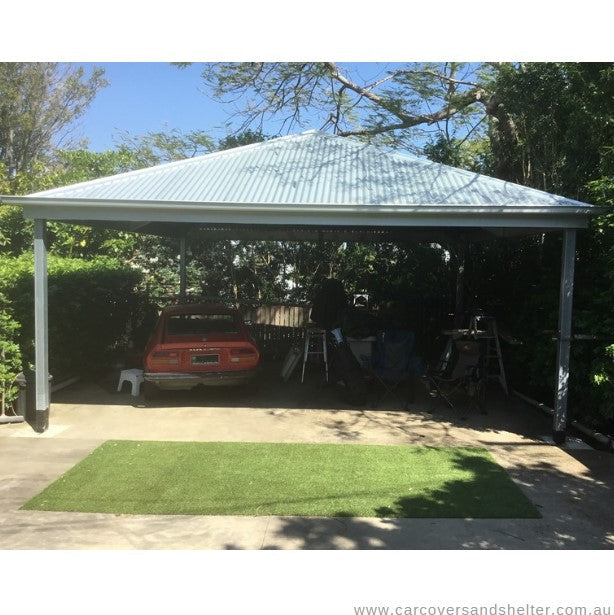
How to Design the Perfect Carport
Share
Building a carport is a smart way to protect your vehicles, add value to your property, and create extra covered space so let’s help you by looking at how to design the perfect carport. Designing the perfect carport isn’t just about putting up a roof—it’s about blending functionality, durability, and style. Whether you’re a seasoned handyman or a small business owner looking to maximise your work area, this guide will walk you through essential steps to get your carport right from the ground up.
Two Major Steps in How to Design the Perfect Carport
1. Planning and Preparation: Lay the Foundation for Success
Before picking up your electric drill, get a clear picture of what you need and what your site allows. Careful upfront planning will save you time, money, and headaches later.
Assess Your Space for a Carport
Measure your area: Consider how many vehicles you need to shelter and their sizes. Don’t

Future-proof your Carport Space
If you might add a vehicle or two later, plan extra space now to avoid costly modifications. Also, consider if you may like to add solar panels to the roof of your carport at a later stage. Ensuring your carport is ‘solar-ready’ from the start will also avoid costly alterations later.
Consider Your Home’s Style for a Carport Canopy
Match materials and colours and roof style. A carport can be designed as: -
a) A Skillion roof carport
b) Gable roof carport
c) Hip Roof carport or
d) A Dutch Gable Roof Carport
A carport is an extension of your property. Timber might suit classic homes, while steel or Colorbond complements modern designs, is easier to install and less maintenance.
Keep Your Carport Kit Cohesive
Think about roof lines and architectural features—your carport should look like it belongs.
Factor in Climate in Your Carport Kit Design
Protect against local elements: Strong winds, heavy rain, and harsh sun affect material choice and design. For instance:

a) Sloped roofs handle rain and snow better.
b) Durable, weather-resistant materials last longer with less upkeep.
c) Check Council Approvals and Regulations
Research local rules: Regulations around size, setbacks, and materials vary. Getting permits ensures your project stays hassle-free.
Avoid fines: Building without approval can lead to costly penalties or forced removal.
Set Your Budget - DIY Carport Kit
Be realistic: Decide how much you’re willing to spend upfront. You can save by installing the carport yourself. All carport kits come with good instructions and the Professional Choice Custom-made range has state-of-the-art drawings with every joint linked to a YouTube video.
Prioritise essentials: Allocate budget to structural integrity and weatherproofing first, then add features like storage or lighting as funds allow.
2. Design and Features: Building for Function and Form, How to Design the Perfect Carport
With your groundwork done, let’s move on to the nitty-gritty—the actual design.
Open vs. Enclosed Carport Shed
a) Open carport: Easier and cheaper to build, great for quick vehicle access and ventilation.
b) Enclosed carport: Offers better protection from elements and theft but requires walls and a much stronger design.
Carport Roof Design (See also “Consider Your Home’s Style”.
Sloping roof: Essential for draining rainwater efficiently.
Gable: Classic look with two slopes.
Skillion (single slope): Simple and modern, easier for drainage.
Choose a style that complements your home and handles local weather.
Carport Materials Matter
Timber: Warm, natural look; good for DIY, usually more expensive and will require upkeep.
Steel: Strong, durable, low maintenance; better for commercial or long-term use and easy DIY.
Lighting Considerations
Safety first: Bright, well-placed lighting reduces accidents when parking at night.
Energy efficient: Use LEDs or motion sensors to save on electricity and maintenance.
Drainage Solutions
Prevent pooling: Install gutters, downpipes, and ensure proper ground slope around the carport.
Protect foundations: Good drainage prolongs structural life by avoiding water damage.
Aesthetic Details in your Kit Carport
Architectural trims: Adds character and can mimic your home’s details.
Landscaping: Surround with plants or paving to enhance curb appeal and prevent mud tracking.
Summary, How to Design the Perfect Carport Your Perfect Carport Starts Here
Designing a carport that works for your property, stands up to your climate, and complements your home style isn’t complicated—it’s about thoughtful choices and smart planning. With the right dimensions, materials, and features, you can build a durable carport that protects your vehicles and adds valuable covered space for years to come.
Remember, the best projects come from careful prep and a clear plan. Take your time, stick to your budget, and don’t hesitate to ask for advice when needed. You’ve got the skills and knowledge —now it’s time to build!
Carport Kits designed for You
If you’re ready to take the next step, explore the range of DIY carport kits and professional support options designed to make your build straightforward and affordable. Roll up your sleeves and get started today! Call Car Covers and Shelter and we can talk through your options.
